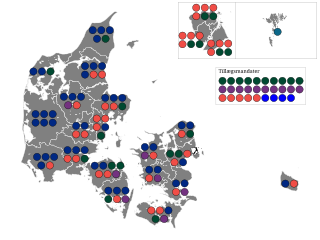
The Landsting was the upper house of the Rigsdag, from 1849 until 1953, when the bicameral system was abolished in favour of unicameralism. The Landsting had powers equal to the Folketing, which made the two houses of parliament hard to distinguish.

Folketing elections were held in Denmark on 26 April 1920, except in the Faroe Islands, where they were held on 20 May. The election campaign was the most aggressive and bitter in Denmark in the 20th century. Voter turnout was 80.6% in Denmark proper and 58.8% in the Faroe Islands.

Landsting elections were held in Denmark on 11 May 1918, with the exceptions that the seats elected by the resigning parliament were elected on 20 March 1918, the Faroese member was elected on 13 May, and the electors that elected the candidates standing in the constituencies were elected on 30 April.

Landsting elections were held in Denmark on 10 August 1920, with the exceptions that the seats elected by the resigning parliament were elected on 26 June, the Faroese member was elected on 23 August, and the electors that elected the candidates standing in the constituencies were elected on 30 July.

Landsting elections were held in Denmark on 1 October 1920, with the exceptions that the seats elected by the resigning parliament were elected on 10 September, except for the representative of South Jutland County who was elected on October 7, the Faroese member was elected on 3 February 1921, and the electors that elected the candidates standing in the constituencies were elected on 24 September 1920.

Landsting elections were held in Denmark on 14 April 1939, with the exception that the electors that elected the candidates standing in the constituencies were elected on 3 April.

Folketing elections were held in Denmark on 20 April 1892.

Folketing elections were held in Denmark on 21 January 1890.

Folketing elections were held in Denmark on 28 January 1887.

Folketing elections were held in Denmark on 25 June 1884.

A referendum on the sale of the Danish West Indian Islands to the United States of America was held in Denmark on 14 December 1916. The non-binding referendum saw 283,670 vote in favor of the sale of the Danish West Indian Islands and 158,157 against. The residents of the islands were not allowed to vote on the matter, but in an unofficial vote on Saint Croix arranged by David Hamilton Jackson, 4,027 voted in favor of the sale and only seven voted against. As a result of the referendum the islands were formally relinquished to the United States by the Treaty of the Danish West Indies on 31 March 1917 as the United States Virgin Islands for a sum of US$25,000,000 in gold.

Landsting elections were held in Denmark on 21 September 1928, with the exceptions that the electors were elected on 14 September, that the candidates elected by the resigning parliament were elected on 15 August, and that the Faroese candidate was elected by the Løgting on 23 August.

Landsting elections were held in Denmark on 13 September 1932, with the exception that the electors were elected on 5 September.
The Society of the Friends of Peasants was a liberal Danish political society founded on 5 May 1846 by members of the provincial consultative assemblies Johan Christian Drewsen and Balthazar Christensen, with the intent to promote the liberation of the peasantry and equality among the different classes of society. Among its most politically influential members were Anton Frederik Tscherning, Jens Andersen Hansen and Carl Christian Alberti.

Landsting elections were held in Denmark on 6 April 1943, with the exception that the electors were elected on 23 March. Along with the corresponding Folketing election, it was the first election during the German occupation, and although many people feared how the Germans might react to the election, the event took place peacefully.

Andreas Frederik Krieger was a Danish politician, government minister, professor of law and supreme court judge. He was a member of the National Constitutional Assembly from 1848 to 1849, a member of the Folketing from 1849 to 1852 representing the National Liberal Party and a member of the Landsting from 1863 to 1890 representing first the National Liberal Party and later the conservative party Højre.

Carl Christian Vilhelm Liebe was a Danish politician representing first the National Liberal Party and later the conservative Højre, lawyer and speaker of the Landsting, a chamber of the parliament. He was an elected member of the Folketing from 1861 to 1866, and a royally appointed member of the Landsting from 1866 to 1895.

Hans Christian Steffensen was a Danish politician, jurist and speaker of the Landsting, a chamber of the parliament.

Landsting elections were held in Denmark in March and April 1947. The public elected members of the electoral college on 1 April, who in turn elected 29 members of the Landsting on 11 April. A further 19 members were elected by outgoing parliament on 7 March, while a Faroese member was elected by the Løgting on 26 March.








